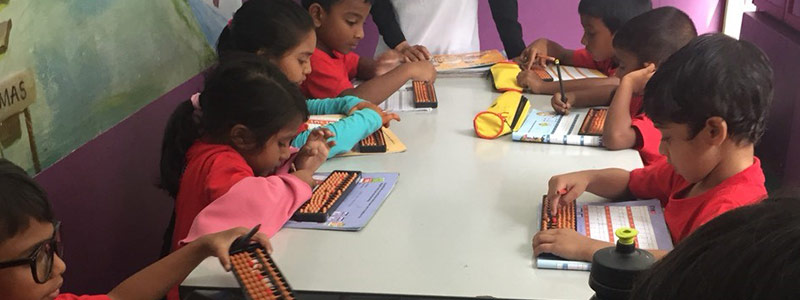Eligibility Details
- All normal children in age group of 4-14 years
- All children who can count numbers from 0-30
- Children with plentiful imagination
- Children who would like to improve, academically
Course Structure
| Term | For children above 4 years |
|---|---|
| Regular Course | |
| I | Basic |
| II | Elementary A |
| III | Elementary B |
| IV | Intermediate A |
| V | Intermediate B |
| VI | Higher A |
| VII | Higher B |
| VIII | Advance |
| IX | Grand Level 1 |
| X | Grand Level 2 |
Why Abacus – The unique U C MAS Way
ABACUS is an “… educational toy in the west and a business tool in the Orient, it has an important place in technological history. A primitive ancestor to the electronic computers of today, the Abacus is a milestone in the use of mathematics to master the Physical world…” HARTLEY HOWE – COURTESY TO ENCYCLOPEDIA VOL.1 EDITION: 1999
A few years ago in a little province of Zhusuan in China, it was found that abacus could be instrumental in developing a skill of absorbing all information through LISTENING and SEEING and processing it accurately at the best speed in the right side of human brain. The use of Abacus in mental arithmetic has been refined by us – the U C MAS approach – and this programme has proved to enhance listening skills, concentration , imagination, clarity , photographic memory and to attain all-round academic proficiency, apart from speed and accuracy in mental arithmetic.

In many western countries today, the Abacus is seen chiefly as a kindergarden teaching tool. In the Middle East, Russia, and the Orient, it is still very much a part of modern life, used not only by tradesmen but business offices too. The Russian Abacus is a frame of ten undivided rods holding ten beads each, called the S’choty. A somewhat similar Abacus is called a Choreb by Armenians and Coulba by Turks Apparently developed among the Arabs or Persians, the Abacus was carried northward of Russia in comparatively recent times.
As a result of innovative designs and methods of operation, the use of the abacus has actually been increasing in recent decades. The wide usage of the Abacus is part of the arithmetic curriculum in grade schools. Some abacisats trained in special schools are recognized as skilled professionals. They are certified and licensed as first-grade, second-grade, and third-grade operators according to speed and accuracy.
From this it is imperative that `The Abacus’ is an integral part of the arithmetic curriculum in many countries. The Japanese abacisats are recognized as skilled professionals. The speed and accuracy of Abacus calculations was demonstrated in 1946 in Japan in a contest held between a Japanese soroban (Abacus) expert and a highly skilled desk-calculator operator, selected by competition among U S Army payroll-clerks. The Abacus came out ahead in addition, subtraction, division, and problems involving combinations of these mathematical operations. The electronic calculator won only the multiplication contest.
In a nutshell, ABACUS is a boon to parents and teachers the world over. Its simple technique taught in early childhood, has survived the onslaught of time, because of its proven technique for brain development amongst children.

